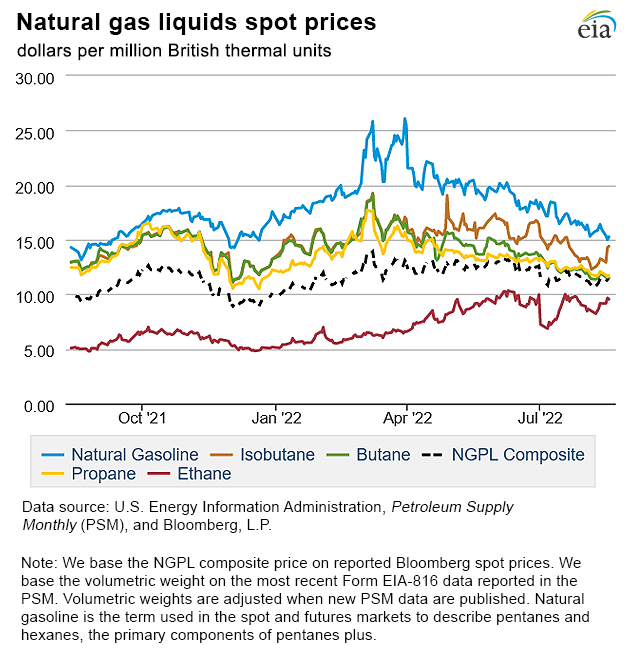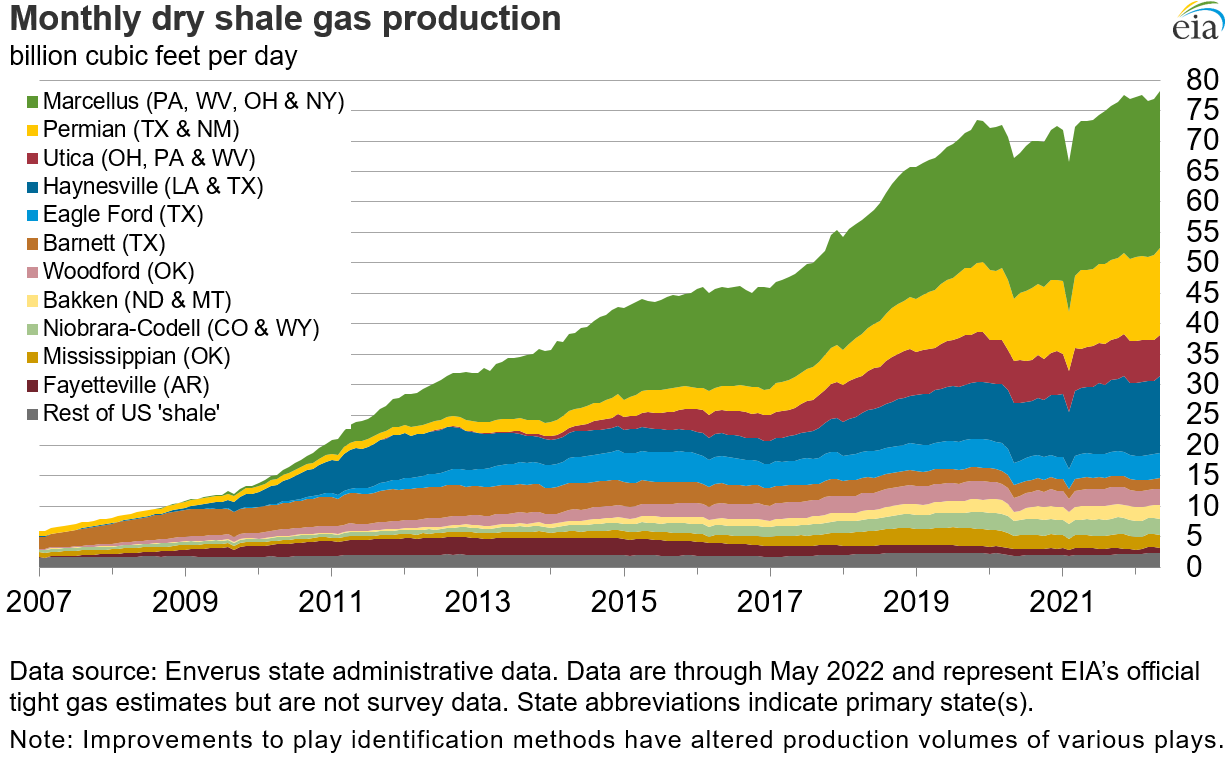In the News:
U.S. ethane production forecast to grow by 9% in second half of 2022
Ethane production at U.S. natural gas processing plants, which has been growing annually since 2017, rose to just above 2.5 million barrels per day (b/d) in March, and has remained above 2.4 million b/d since then. In our August Short-Term Energy Outlook (STEO), we forecast average ethane production to grow by 9% to over 2.6 million b/d in the second half of 2022. The forecast 2022 annual production exceeds 2021 production by 16%, or 340,000 b/d.
Our STEO forecasts annual production to increase by 7% to nearly 2.7 million b/d in 2023, reflecting expected further growth in both domestic consumption and exports. Growth in domestic consumption is from three new petrochemical crackers, two along the Gulf Coast that started operations this year and one in Pennsylvania, which is expected to come online in the second half of 2022.
For the most part since 2017, ethane prices relative to natural gas prices have remained at a premium, spurring natural gas plant operators to recover increasing quantities of ethane from their raw natural gas streams. Natural gas plant operators have some discretion in deciding to recover ethane from the raw natural gas stream. When ethane prices are relatively high, more ethane will be recovered for sale into the liquids market. When ethane prices are relatively low, more ethane will be left in the processed natural gas stream (a practice called ethane rejection) and sold at the natural gas energy-equivalent value. Throughout 2021, ethane prices were, on average, 80 cents per million British thermal units (MMBtu), or 26%, higher than dry natural gas, driving higher rates of recovery. In the first half of 2022, despite higher average natural gas prices, the ethane premium has remained steady at 25%, or $1.36/MMBtu, above the Henry Hub natural gas wholesale price.
Ethane is consumed almost exclusively as a feedstock in petrochemical steam crackers—plants that crack the ethane molecule to produce ethylene, a precursor chemical in the manufacturing of many plastics and resins. In the United States, a significant buildout of petrochemical capacity in recent years has contributed to growing demand for ethane feedstock. More recently, demand for ethane overseas, also used as petrochemical feedstock, has been growing.
We expect the rapid pace of growth in ethane production to slow in our long-term projection. Our Annual Energy Outlook 2022 (AEO2022) projects ethane production to plateau at around 2.7 million b/d through 2029. A renewed period of slow but generally steady growth will start after 2030, when higher demand for natural gas is expected to drive higher natural gas production. Increasing natural gas production results in higher production of natural gas plant liquids (NGPL), including ethane, which we project to peak at just above 3.0 million in 2050, the end of the AEO2022 projection period. The majority of ethane supply growth in the longer term is in the U.S. East region, where we expect ethane production to grow from 300,000 b/d in 2021 to more than 980,000 b/d by 2050, a 223% increase.
Market Highlights:
(For the week ending Wednesday, August 17, 2022)Prices
- Henry Hub spot price: The Henry Hub spot price rose $1.62 from $7.89 per million British thermal units (MMBtu) last Wednesday to $9.51/MMBtu yesterday.
- Henry Hub futures prices: The price of the September 2022 NYMEX contract increased $1.042, from $8.202/MMBtu last Wednesday to $9.244/MMBtu yesterday. The price of the 12-month strip averaging September 2022 through August 2023 futures contracts climbed 81.3 cents to $7.545/MMBtu.
- Select regional spot prices: Natural gas spot prices rose at most locations this report week (Wednesday, August 10, to Wednesday, August 17). Week-over-week increases at major pricing hubs ranged from 63 cents at Malin, located on the California-Oregon border, to $1.89 at SoCal Citygate in Southern California.
- The price at PG&E Citygate in Northern California rose $1.28, up from $9.14/MMBtu last Wednesday to $10.42/MMBtu yesterday. In northern California, PG&E’s maintenance schedule includes ongoing work on the Redwood pipeline and Buckeye station through the end of the month. The Redwood pipeline delivers natural gas from Malin, Oregon, to the San Francisco Citygate. PG&E expects available pipeline capacity to be between 70% and 90% for the next few weeks.
- The price at SoCal Citygate in Southern California rose $1.89, up from $10.21/MMBtu last Wednesday to $12.10/MMBtu yesterday. In the Southwest, El Paso Natural Gas Company rescheduled pipeline remediation on Line 1100 from Wenden, Arizona, to Ehrenberg, Arizona, but continues to report that 450 million cubic feet per day (MMcf/d) of natural gas is currently unavailable due to the on-going repair of Line 2000. In the Permian Basin of New Mexico, a major region of production that supplies natural gas to California, production fell 0.3 billion cubic feet per day (Bcf/d) week over week, or 6%, according to data from PointLogic. Temperatures across California remain high. The California ISO issued a Flex Alert on Tuesday urging consumers to reduce energy usage on Wednesday to protect the grid.
- At the Algonquin Citygate, which serves Boston-area consumers, the price increased 90 cents from $7.64/MMBtu last Wednesday to $8.54/MMBtu yesterday, reaching a low of $7.56/MMBtu on Monday. Prices in the Northeast rose with the national average this report week, but they rose less than prices in other regions due to cooler weather. Natural gas production from the Appalachia subregion fell 0.3 Bcf/d (1%) week over week. Temperatures in the Boston Area averaged 71°F this report week, compared with 83°F last report week. Natural gas consumption across the Northeast region fell by 4.0 Bcf/d (22%), almost entirely due to reduced consumption in the electric power sector, according to data from PointLogic. At the Transcontinental Pipeline Zone 6 trading point for New York City, the price increased $1.01 from $7.43/MMBtu last Wednesday to $8.44/MMBtu yesterday, reaching a low of $7.41/MMBtu on Friday. Temperatures in the New York Central Park Area averaged 75°F this report week, compared with 84°F last report week.
- The FGT Citygate spot price increased 79 cents from $10.56/MMBtu last Wednesday to $11.35/MMBtu yesterday. The FGT Citygate price has been generally falling from a recent high of $16.71/MMBtu set on July 26. The FGT Citygate price reflects deliveries into Florida via the Florida Gas Transmission pipeline. A constraint at Compressor Station 60 (CS 60) on William’s Transco pipeline, which serves the Gulf Coast and Southeast regions, continues to affect the region. CS 60 is approximately 25 miles north-northwest of Baton Rouge in Louisiana.
- International futures prices: According to Bloomberg Finance, L.P., weekly average futures prices for liquefied natural gas (LNG) cargoes in East Asia increased $5.33 to a weekly average of $49.94/MMBtu, and natural gas futures for delivery at the Title Transfer Facility (TTF) in the Netherlands, the most liquid natural gas spot market in Europe, increased $5.91 to a weekly average of $65.07/MMBtu.
- Natural gas plant liquids prices: The natural gas plant liquids composite price at Mont Belvieu, Texas, rose by 45 cents/MMBtu, averaging $11.35/MMBtu for the week ending August 17. The price of ethane rose 10%, following natural gas prices at the Houston Ship Channel, which rose 11%. Despite the increase in the cost of natural gas, the ethane premium to natural gas widened by 5%. The price of ethylene rose 4%, narrowing the ethylene to ethane spread by 15%. Brent crude oil prices fell 2%, pulling down the price of natural gasoline, which fell 1%. Propane prices remained relatively unchanged, so the propane discount to crude oil narrowed by 9%. The normal butane and isobutane prices rose 1% and 8%, respectively.
Daily spot prices by region are available on the EIA website.
Supply and Demand
- Supply: According to data from PointLogic, the average total supply of natural gas fell by 1.7% (1.8 Bcf/d) compared with the previous report week. Dry natural gas production decreased by 1.1% (1.1 Bcf/d) compared with the previous report week. Average net imports from Canada decreased by 13.2% (0.7 Bcf/d) from last week.
- Demand: Total U.S. consumption of natural gas fell by 8.0% (6.0 Bcf/d) compared with the previous report week driven by a 12.3% (5.4 Bcf/d) week-over-week decline in natural gas consumed for electric power generation, according to data from PointLogic. Cooler temperatures stretched across the East Coast and the Midwest. Industrial sector consumption increased by 0.7% (0.1 Bcf/d) week over week. In the residential and commercial sectors, consumption declined by 7.6% (0.7 Bcf/d). Natural gas exports to Mexico increased 5.2% (0.3 Bcf/d). Natural gas deliveries to U.S. LNG export facilities (LNG pipeline receipts) averaged 11.0 Bcf/d, or 0.2 Bcf/d higher than last week.
Liquefied Natural Gas (LNG)
- Pipeline receipts: Natural gas deliveries to LNG export terminals in South Louisiana increased by 0.1 Bcf/d this report week to 7.6 Bcf/d, while deliveries to terminals in South Texas were essentially flat at 2.3 Bcf/d. Overall natural gas deliveries to U.S. LNG export terminals increased by 0.2 Bcf/d to 11.0 Bcf/d this report week.
- Vessels departing U.S. ports: Nineteen LNG vessels (eight from Sabine Pass, four each from Corpus Christi and Cameron, and one each from Calcasieu Pass, Cove Point, and Elba Island) with a combined LNG-carrying capacity of 70 Bcf departed the United States between August 11 and August 17, according to shipping data provided by Bloomberg Finance, L.P.
Rig Count
- According to Baker Hughes, for the week ending Tuesday, August 9, the natural gas rig count decreased by 1 rig from a week ago to 160 rigs. The Permian and Utica each added one rig, the Arkoma Woodford dropped one rig, and the Marcellus dropped two rigs. The number of oil-directed rigs increased by 3 rigs to 601 rigs. The Cana Woodford added two rigs, the Williston added one rig, and four rigs were added in unspecified producing regions. The Ardmore Woodford dropped two rigs, and the Barnett and Permian each dropped one rig. Three miscellaneous rigs (neither oil- nor natural gas-directed) were dropped, one each in the Marcellus, Williston, and Permian, bringing the total rig count to 763 rigs, which is 262 more than the same week last year.
Storage
- The net injections into storage totaled 18 Bcf for the week ending August 12, compared with the five-year (2017–2021) average net injections of 47 Bcf and last year's net injections of 46 Bcf during the same week. Working natural gas stocks totaled 2,519 Bcf, which is 367 Bcf (13%) lower than the five-year average and 296 Bcf (11%) lower than last year at this time.
- According to The Desk survey of natural gas analysts, estimates of the weekly net change to working natural gas stocks ranged from net injections of 14 Bcf to 43 Bcf, with a median estimate of 29 Bcf.
- The average rate of injections into storage is 7% lower than the five-year average so far in the refill season (April through October). If the rate of injections into storage matched the five-year average of 9.5 Bcf/d for the remainder of the refill season, the total inventory would be 3,278 Bcf on October 31, which is 367 Bcf lower than the five-year average of 3,645 Bcf for that time of year.
See also:
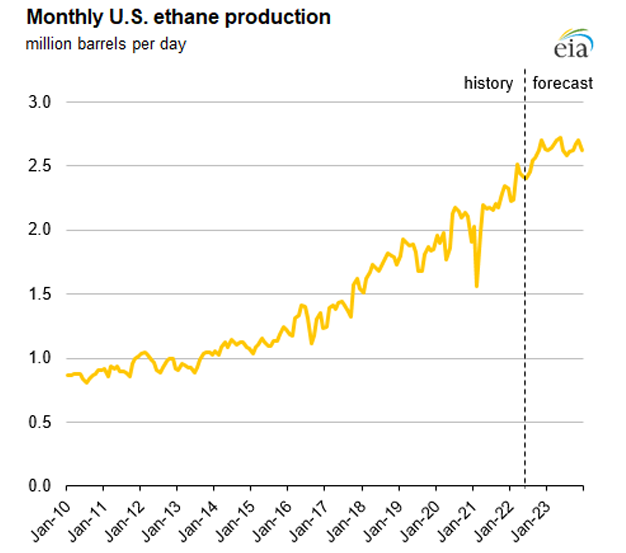 Data source: U.S. Energy Information Administration, Short-Term Energy Outlook
Data source: U.S. Energy Information Administration, Short-Term Energy Outlook
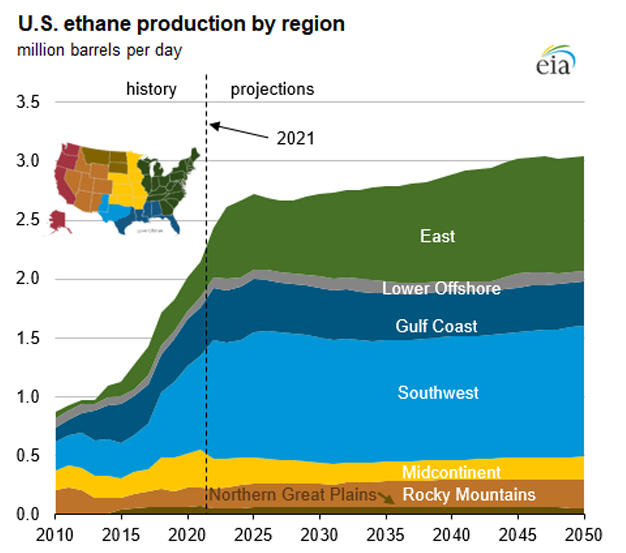 Data source: U.S. Energy Information Administration, Annual Energy Outlook
Data source: U.S. Energy Information Administration, Annual Energy Outlook Download figure data
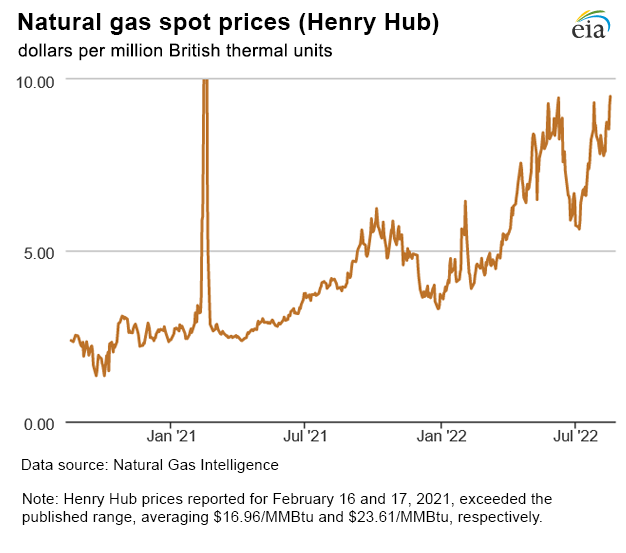
| Spot Prices ($/MMBtu) | Thu, 11-Aug |
Fri, 12-Aug |
Mon, 15-Aug |
Tue, 16-Aug |
Wed, 17-Aug |
|---|---|---|---|---|---|
| Henry Hub |
8.54 |
8.75 |
8.55 |
9.25 |
9.51 |
| New York |
7.49 |
7.41 |
7.67 |
8.38 |
8.44 |
| Chicago |
8.22 |
8.30 |
8.15 |
8.78 |
8.90 |
| Cal. Comp. Avg.* |
9.66 |
9.59 |
9.86 |
10.19 |
10.03 |
| Futures ($/MMBtu) | |||||
| September contract | 8.874 |
8.768 |
8.728 |
9.329 |
9.244 |
| October contract |
8.863 |
8.744 |
8.712 |
9.311 |
9.228 |
| Data source: Natural Gas Intelligence and CME Group as compiled by Bloomberg, L.P. *Avg. of NGI's reported prices for: Malin, PG&E Citygate, and Southern California Border Avg. |
|||||
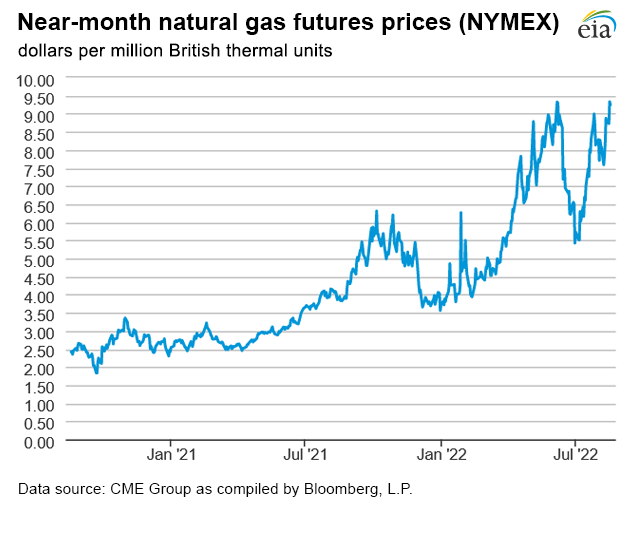
| U.S. natural gas supply - Gas Week: (8/11/22 - 8/17/22) | |||
|---|---|---|---|
Average daily values (billion cubic feet) |
|||
this week |
last week |
last year |
|
| Marketed production | 109.7 |
111.0 |
106.3 |
| Dry production | 97.0 |
98.1 |
93.9 |
| Net Canada imports | 4.5 |
5.2 |
4.8 |
| LNG pipeline deliveries | 0.1 |
0.1 |
0.1 |
| Total supply | 101.6 |
103.4 |
98.7 |
|
Data source: PointLogic | |||
| U.S. natural gas consumption - Gas Week: (8/11/22 - 8/17/22) | |||
|---|---|---|---|
Average daily values (billion cubic feet) |
|||
this week |
last week |
last year |
|
| U.S. consumption | 68.4 |
74.4 |
70.9 |
| Power | 38.5 |
43.9 |
41.4 |
| Industrial | 21.3 |
21.2 |
21.4 |
| Residential/commercial | 8.6 |
9.4 |
8.0 |
| Mexico exports | 5.8 |
5.5 |
6.2 |
| Pipeline fuel use/losses | 6.6 |
6.8 |
6.5 |
| LNG pipeline receipts | 11.0 |
10.8 |
10.4 |
| Total demand | 91.7 |
97.5 |
93.9 |
|
Data source: PointLogic | |||
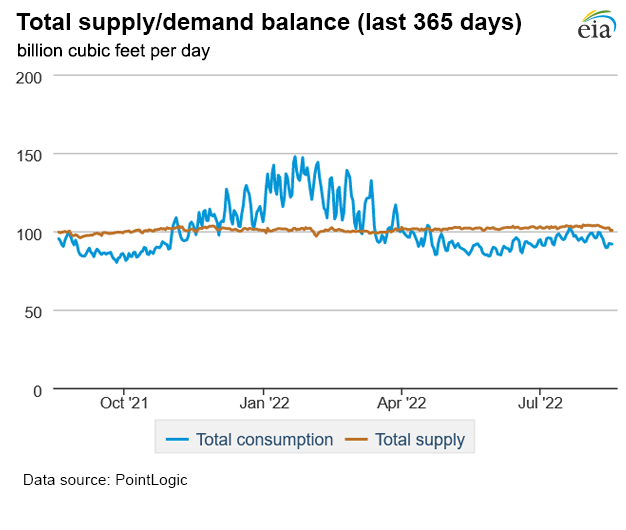
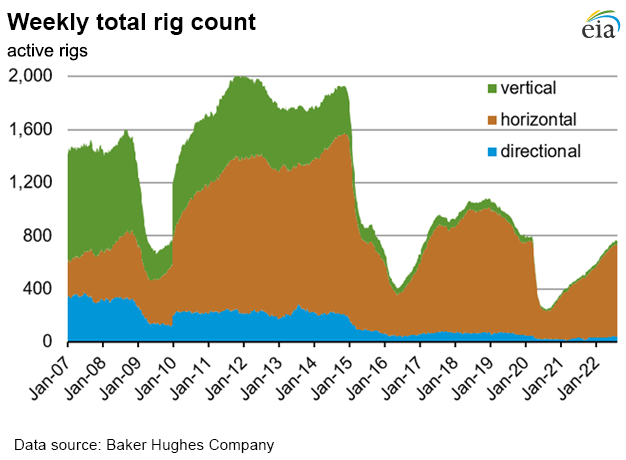
| Rigs | |||
|---|---|---|---|
Tue, August 09, 2022 |
Change from |
||
last week |
last year |
||
| Oil rigs | 601 |
0.5% |
51.0% |
| Natural gas rigs | 160 |
-0.6% |
56.9% |
| Note: Excludes any miscellaneous rigs | |||
| Rig numbers by type | |||
|---|---|---|---|
Tue, August 09, 2022 |
Change from |
||
last week |
last year |
||
| Vertical | 31 |
6.9% |
72.2% |
| Horizontal | 693 |
-0.7% |
52.0% |
| Directional | 39 |
5.4% |
44.4% |
| Data source: Baker Hughes Company | |||
| Working gas in underground storage | ||||
|---|---|---|---|---|
Stocks billion cubic feet (Bcf) |
||||
| Region | 2022-08-12 |
2022-08-05 |
change |
|
| East | 571 |
564 |
7 |
|
| Midwest | 684 |
663 |
21 |
|
| Mountain | 151 |
148 |
3 |
|
| Pacific | 248 |
252 |
-4 |
|
| South Central | 866 |
874 |
-8 |
|
| Total | 2,519 |
2,501 |
18 |
|
| Data source: U.S. Energy Information Administration Form EIA-912, Weekly Underground Natural Gas Storage Report | ||||
| Working gas in underground storage | |||||
|---|---|---|---|---|---|
Historical comparisons |
|||||
Year ago (8/12/21) |
5-year average (2017-2021) |
||||
| Region | Stocks (Bcf) |
% change |
Stocks (Bcf) |
% change |
|
| East | 643 |
-11.2 |
667 |
-14.4 |
|
| Midwest | 762 |
-10.2 |
758 |
-9.8 |
|
| Mountain | 188 |
-19.7 |
183 |
-17.5 |
|
| Pacific | 240 |
3.3 |
272 |
-8.8 |
|
| South Central | 983 |
-11.9 |
1,006 |
-13.9 |
|
| Total | 2,815 |
-10.5 |
2,886 |
-12.7 |
|
| Data source: U.S. Energy Information Administration Form EIA-912, Weekly Underground Natural Gas Storage Report | |||||
| Temperature – heating & cooling degree days (week ending Aug 11) | ||||||||
|---|---|---|---|---|---|---|---|---|
HDDs |
CDDs |
|||||||
| Region | Current total |
Deviation from normal |
Deviation from last year |
Current total |
Deviation from normal |
Deviation from last year |
||
| New England | 0 |
-3 |
-1 |
90 |
48 |
36 |
||
| Middle Atlantic | 0 |
-3 |
0 |
97 |
42 |
27 |
||
| E N Central | 1 |
-4 |
1 |
67 |
14 |
-7 |
||
| W N Central | 1 |
-2 |
1 |
72 |
7 |
-8 |
||
| South Atlantic | 0 |
0 |
0 |
109 |
15 |
12 |
||
| E S Central | 0 |
0 |
0 |
100 |
8 |
7 |
||
| W S Central | 0 |
0 |
0 |
137 |
13 |
11 |
||
| Mountain | 0 |
-3 |
0 |
76 |
4 |
-1 |
||
| Pacific | 0 |
-2 |
0 |
66 |
20 |
2 |
||
| United States | 0 |
-2 |
0 |
91 |
19 |
8 |
||
|
Data source: National Oceanic and Atmospheric Administration Note: HDDs=heating degree days; CDDs=cooling degree days | ||||||||
Average temperature (°F)
7-day mean ending Aug 11, 2022
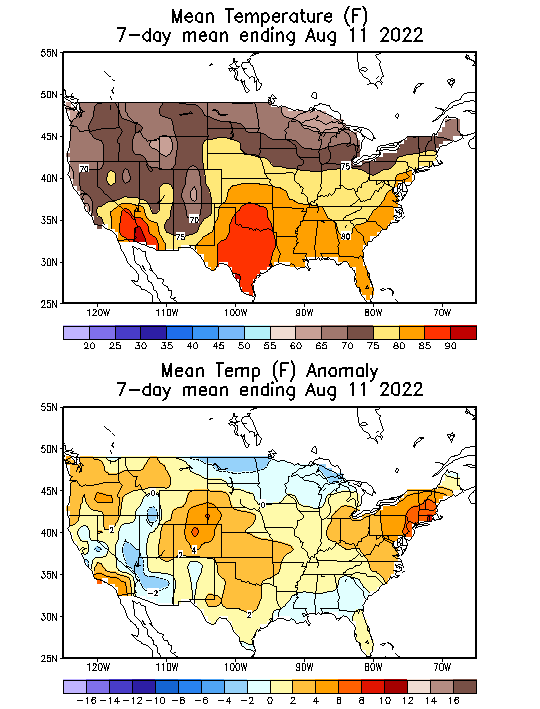
Data source: National Oceanic and Atmospheric Administration
Deviation between average and normal temperature (°F)
7-day mean ending Aug 11, 2022

Data source: National Oceanic and Atmospheric Administration

